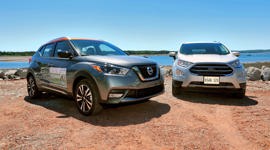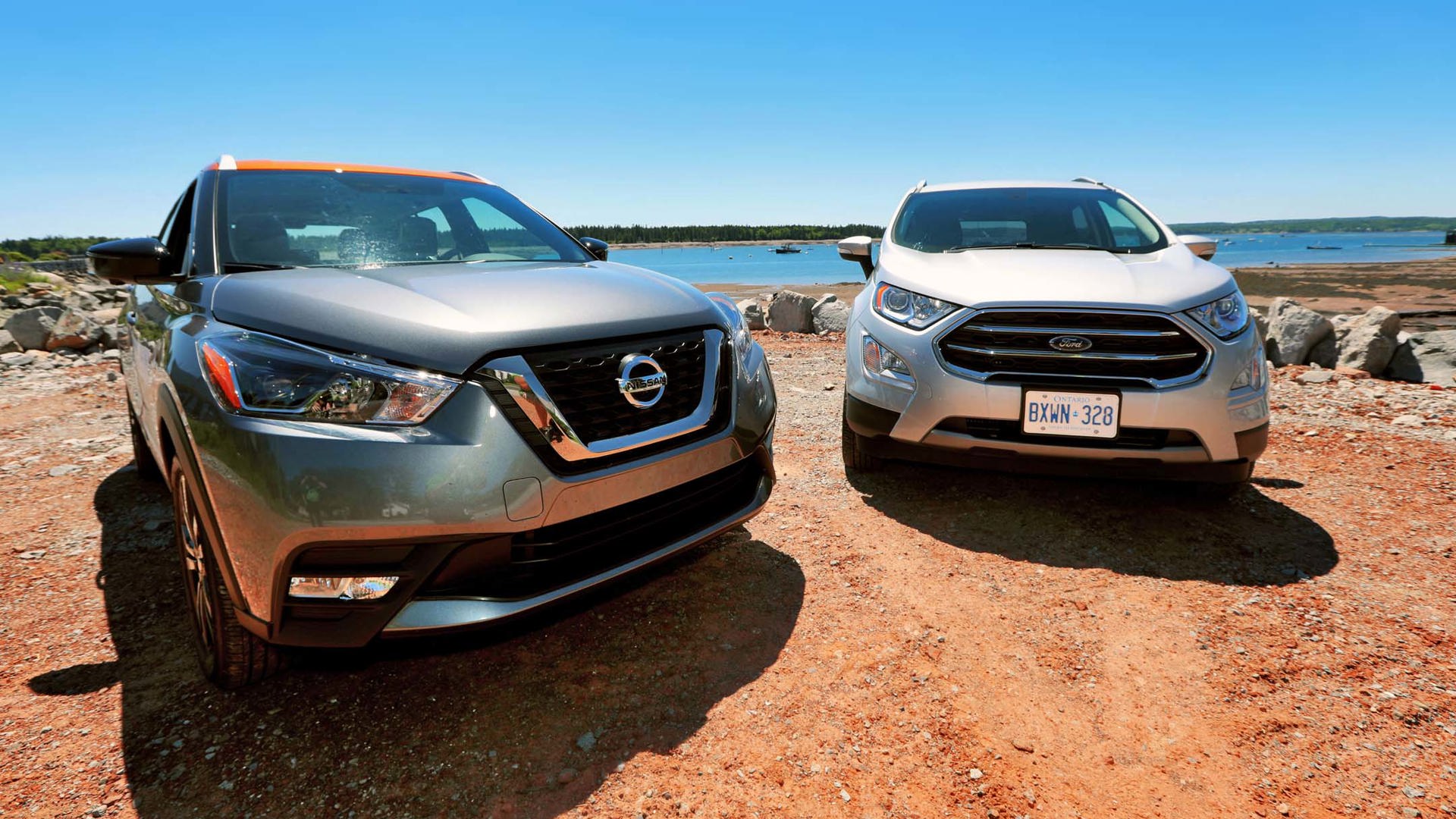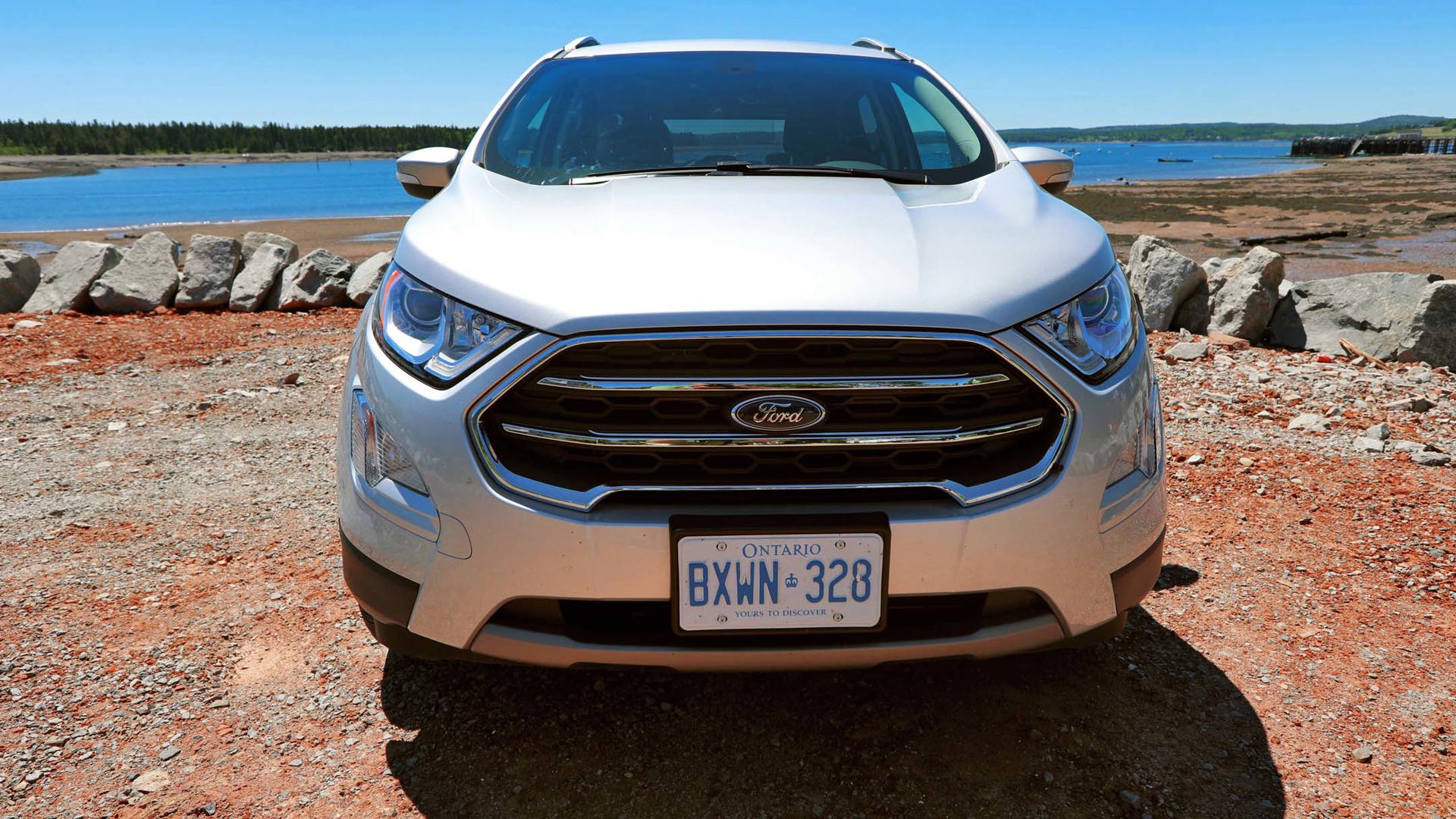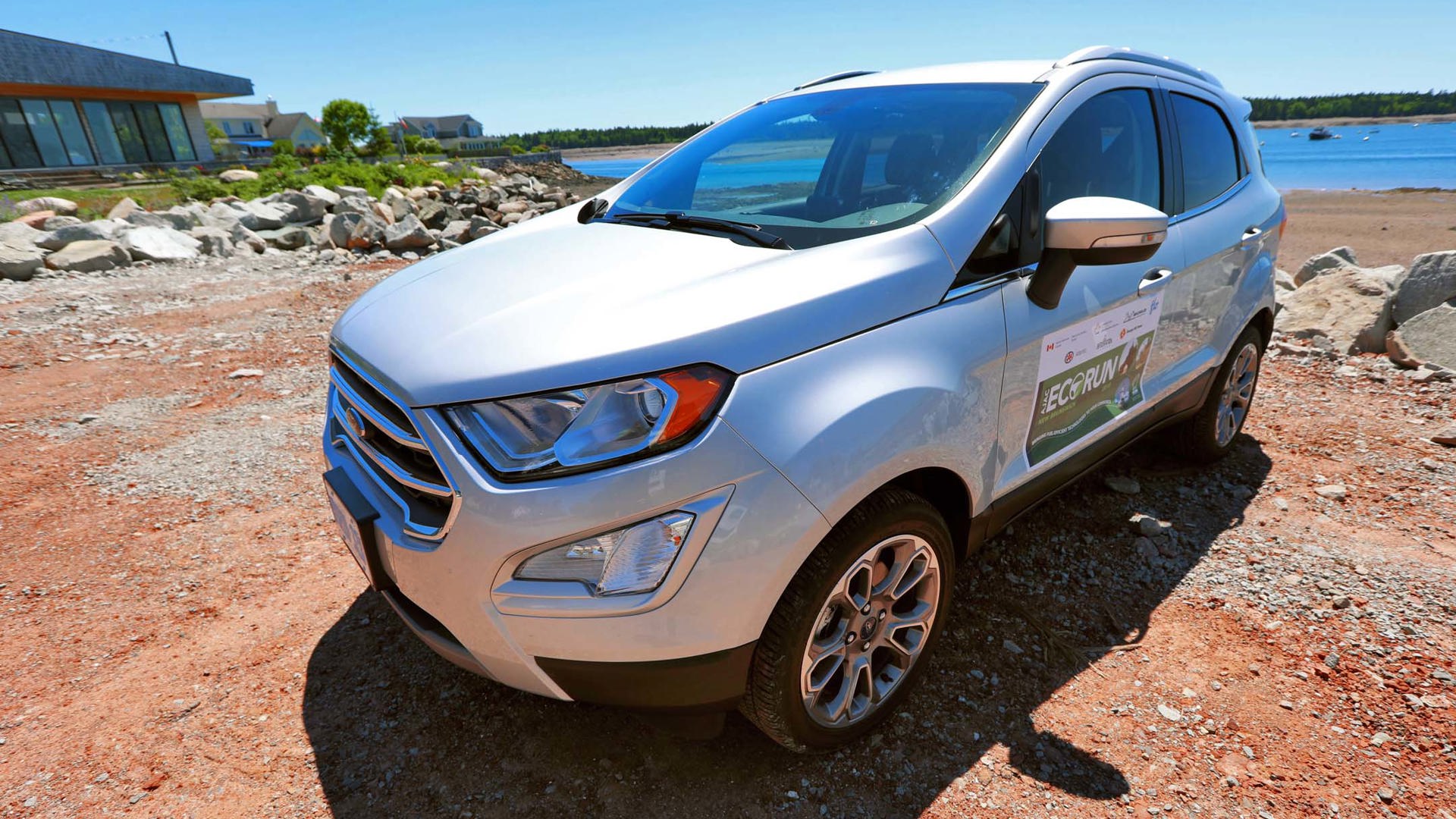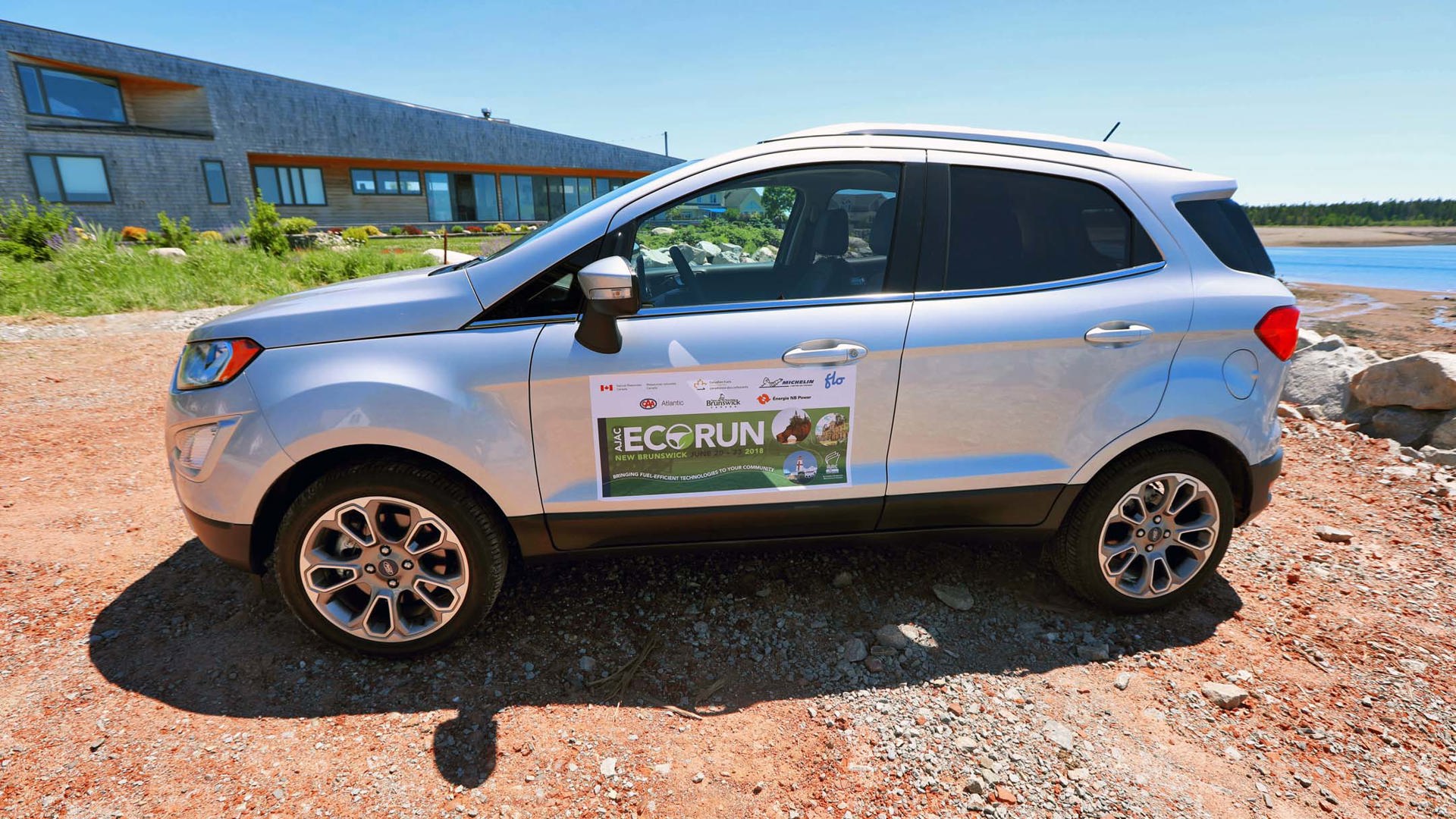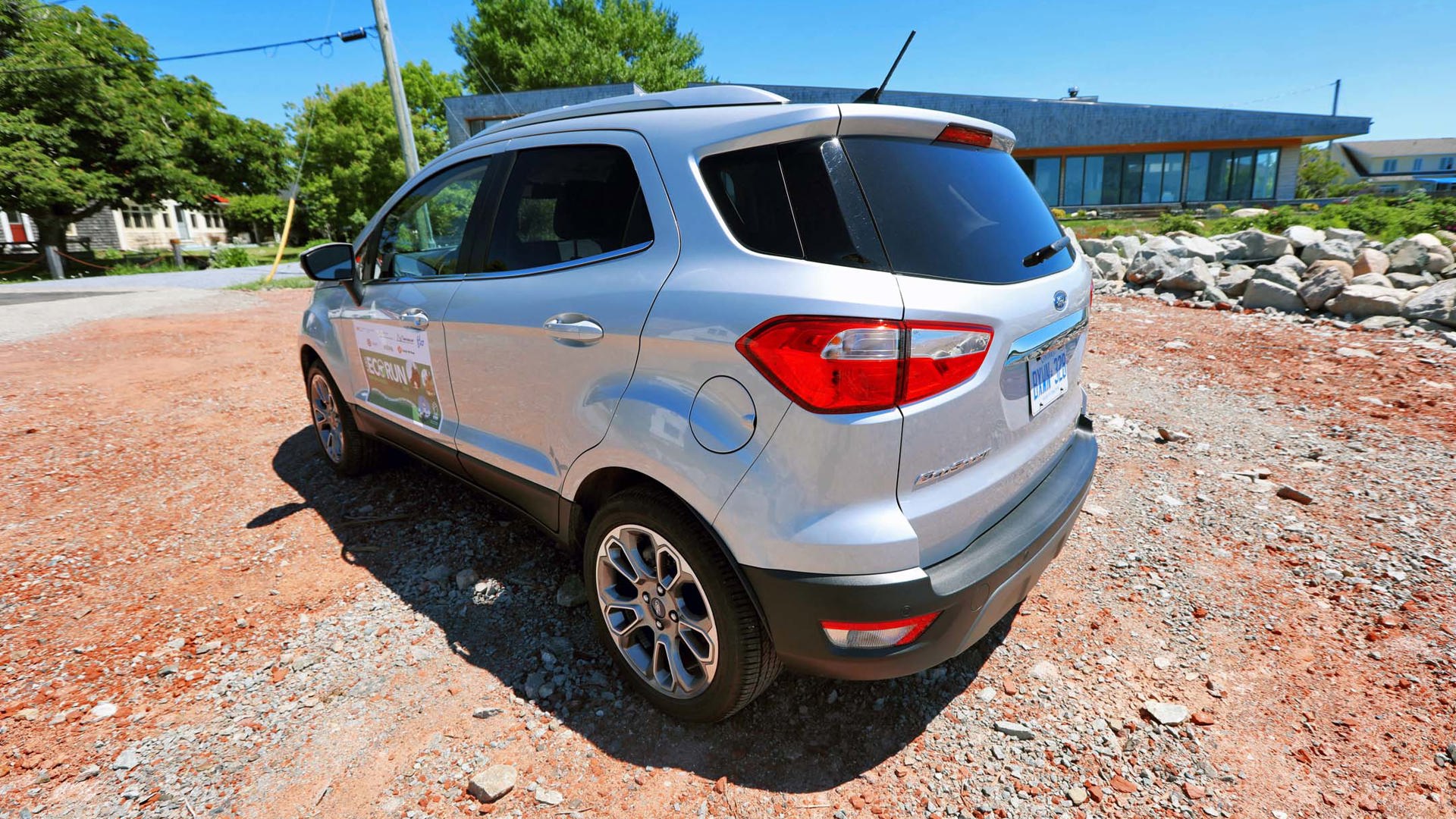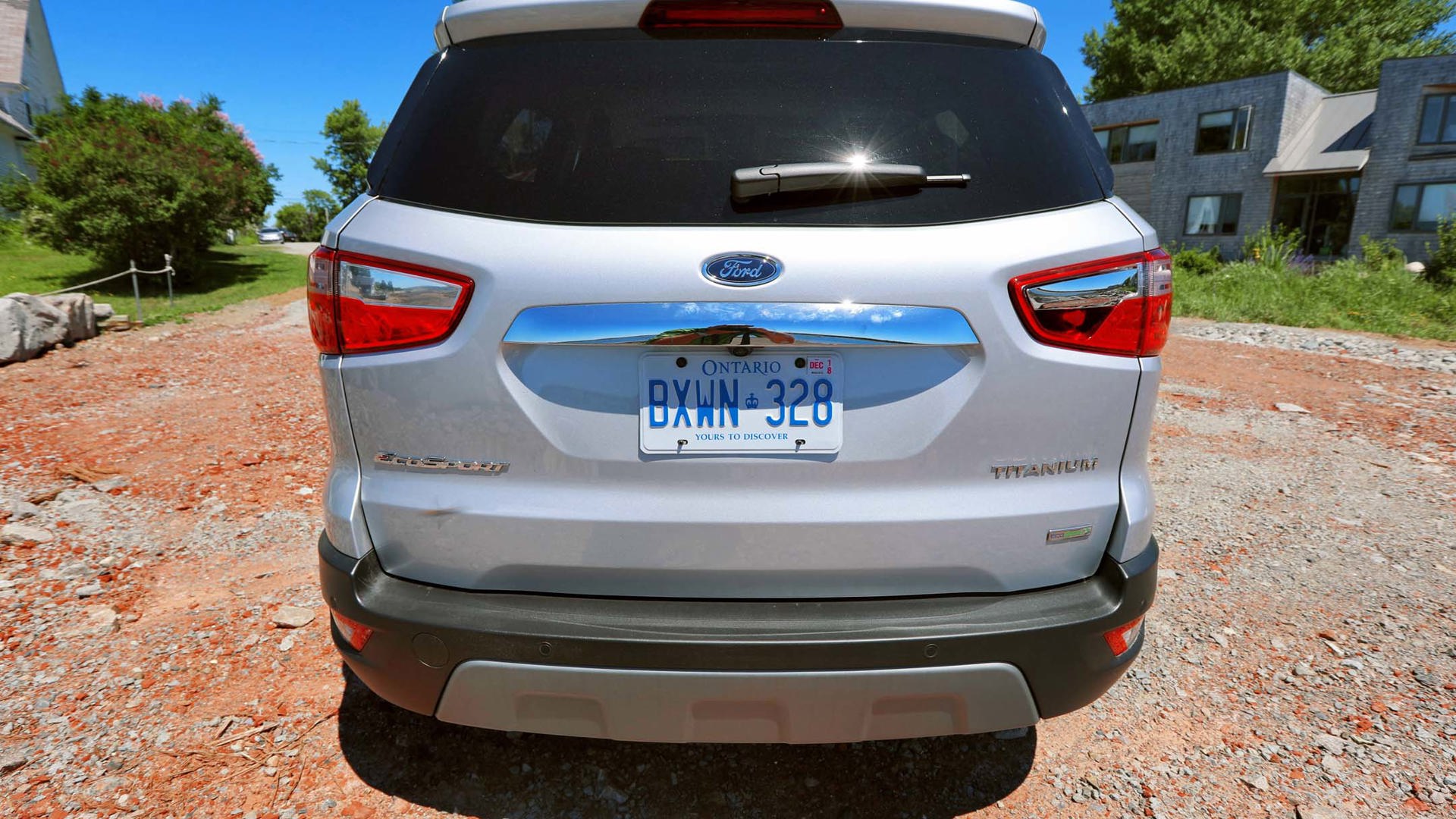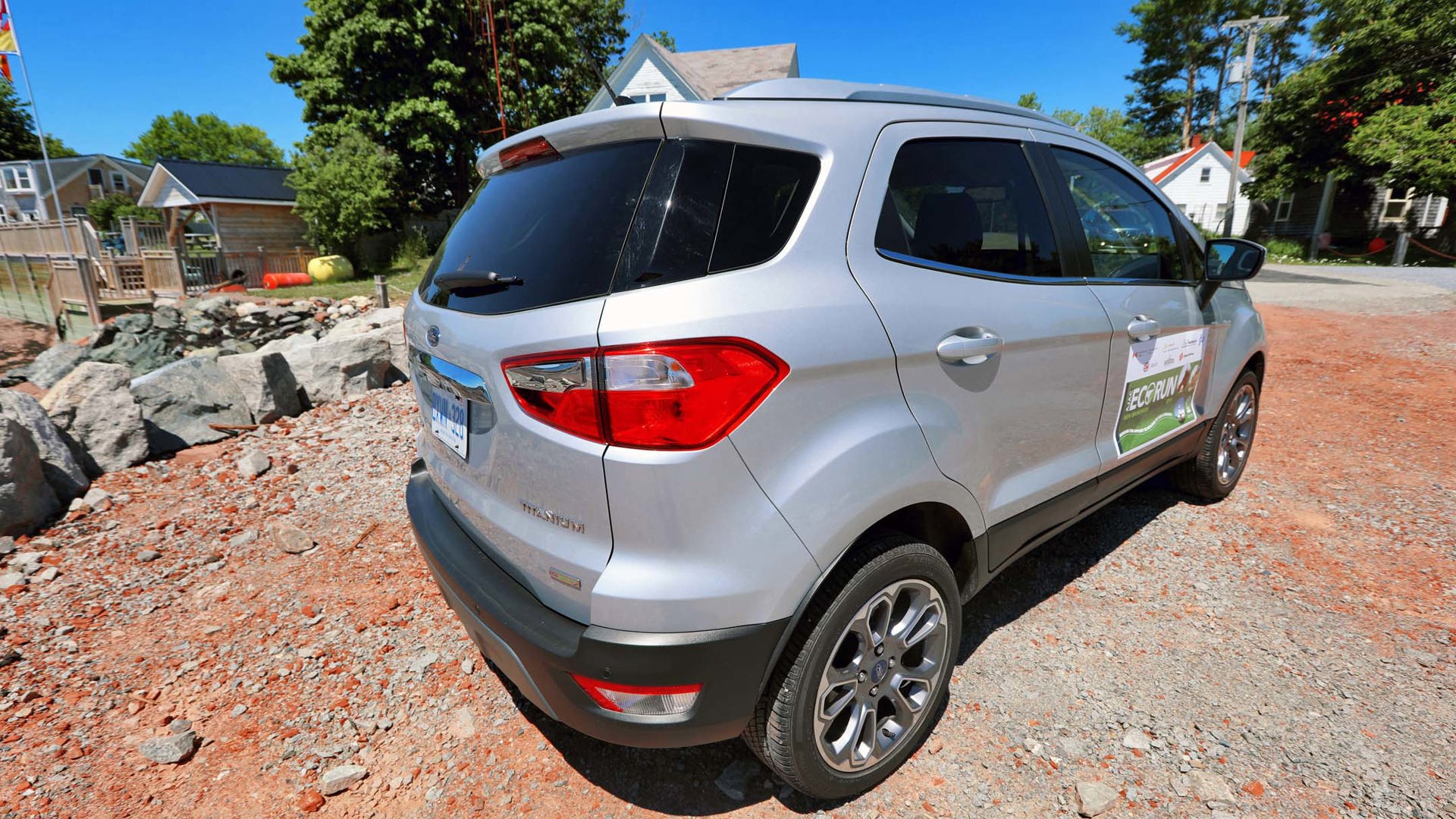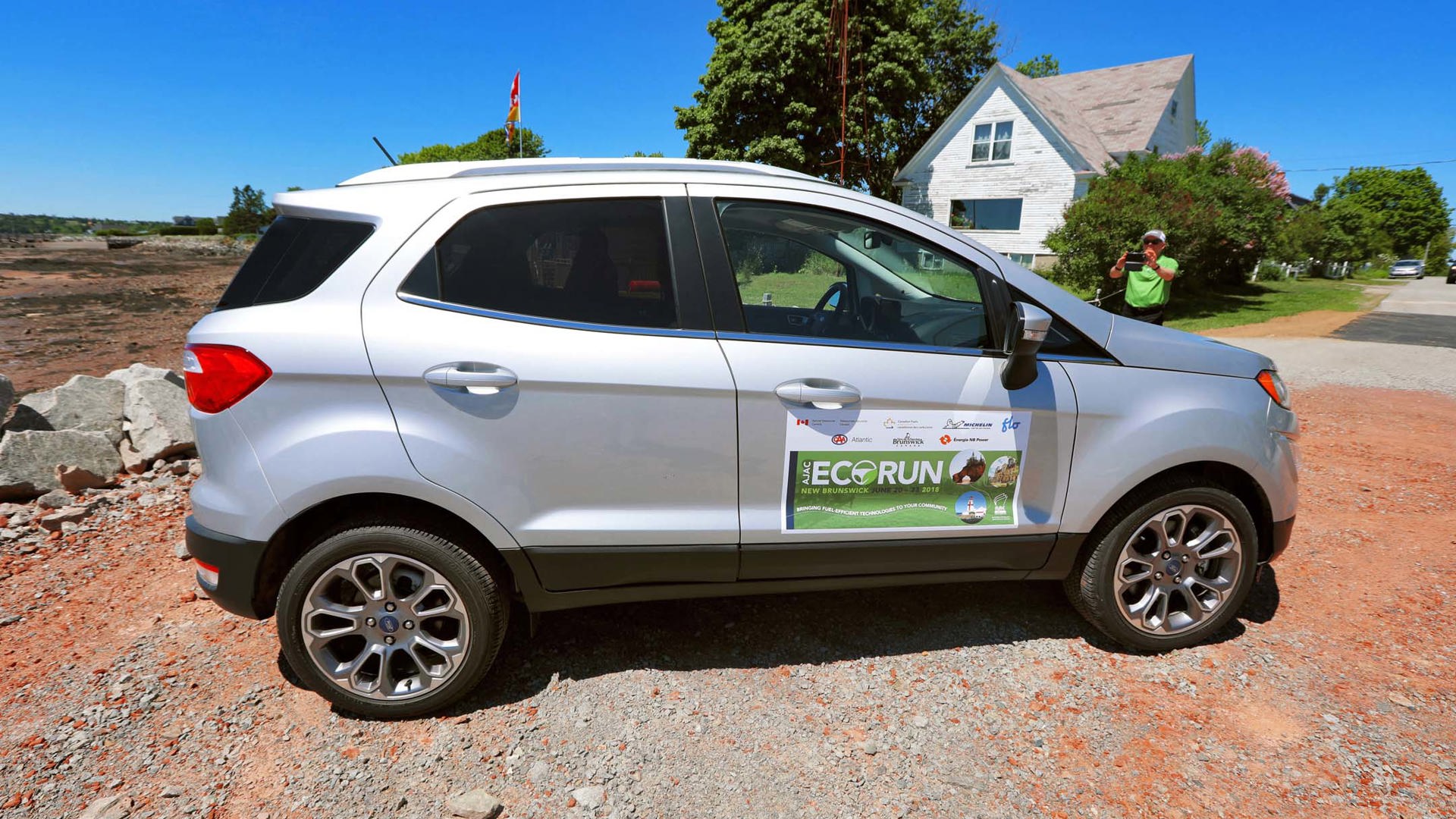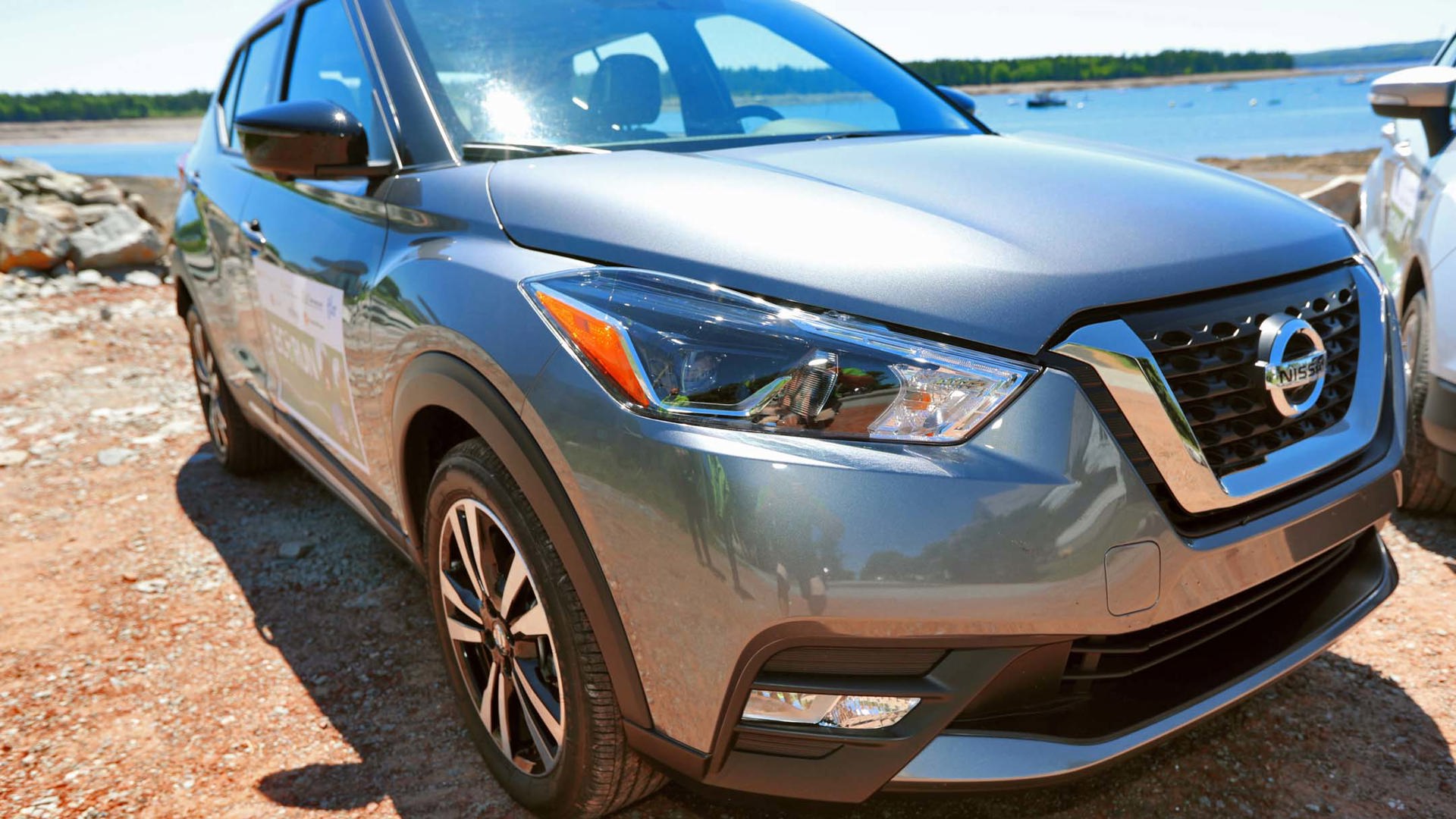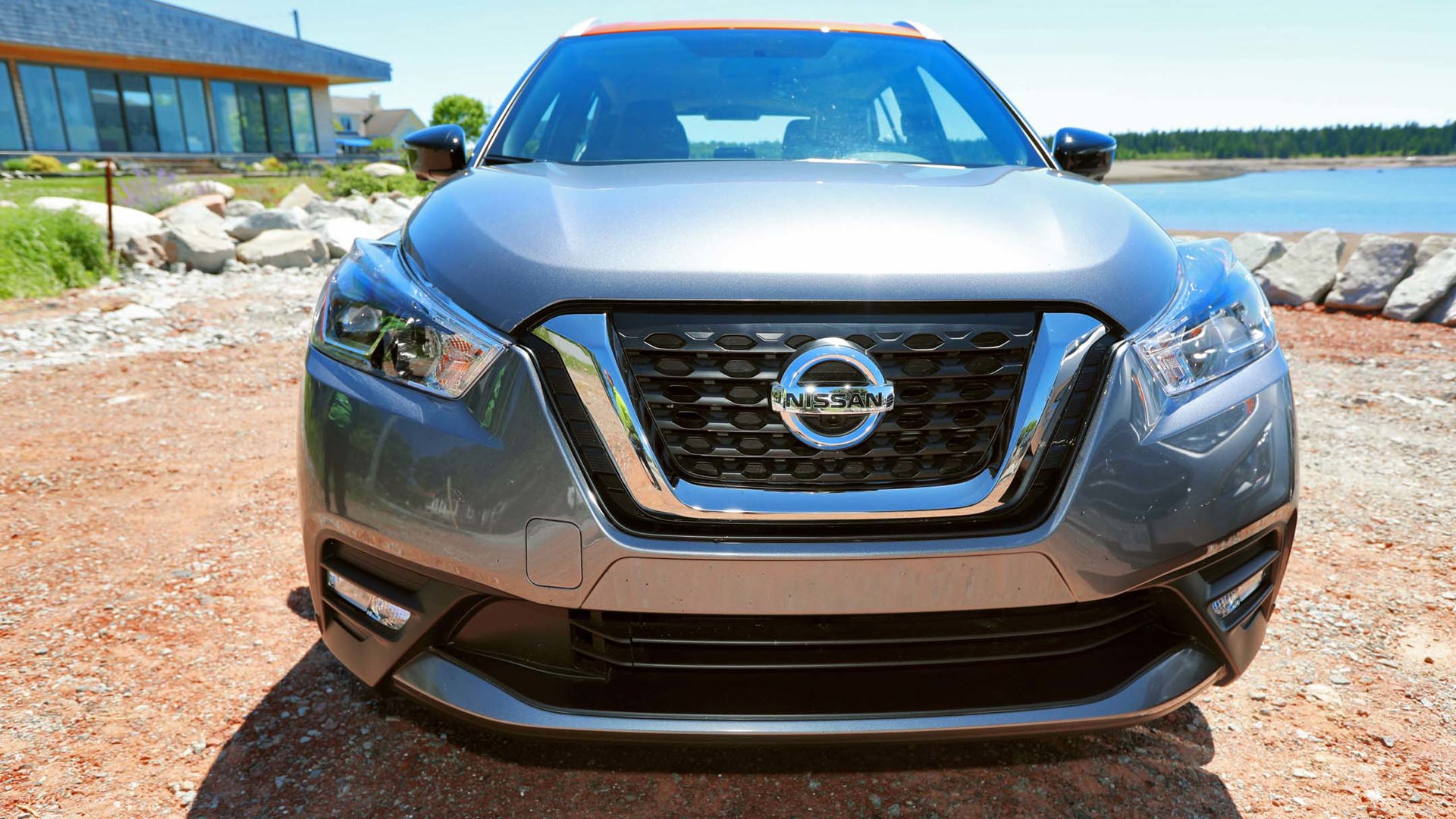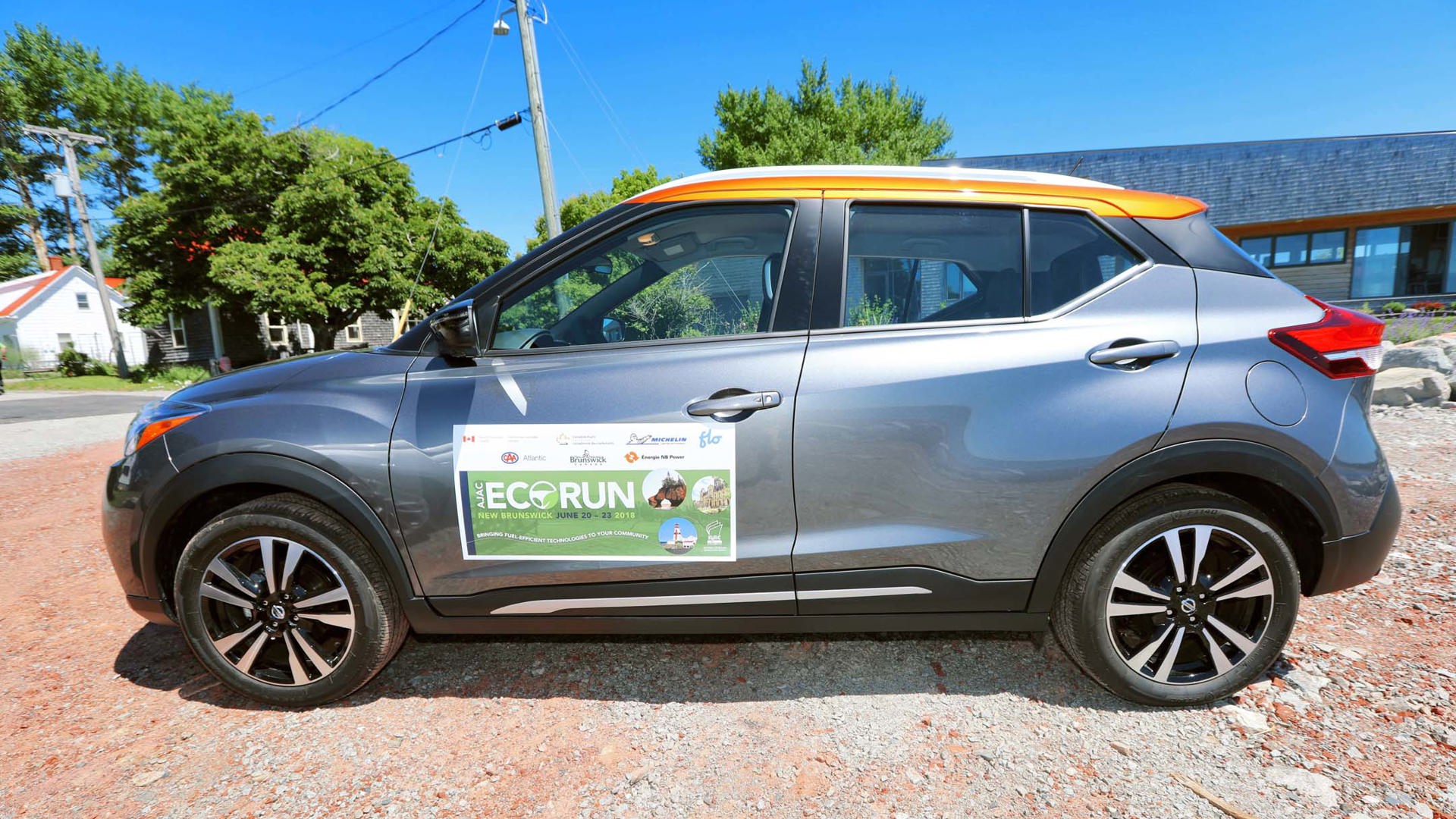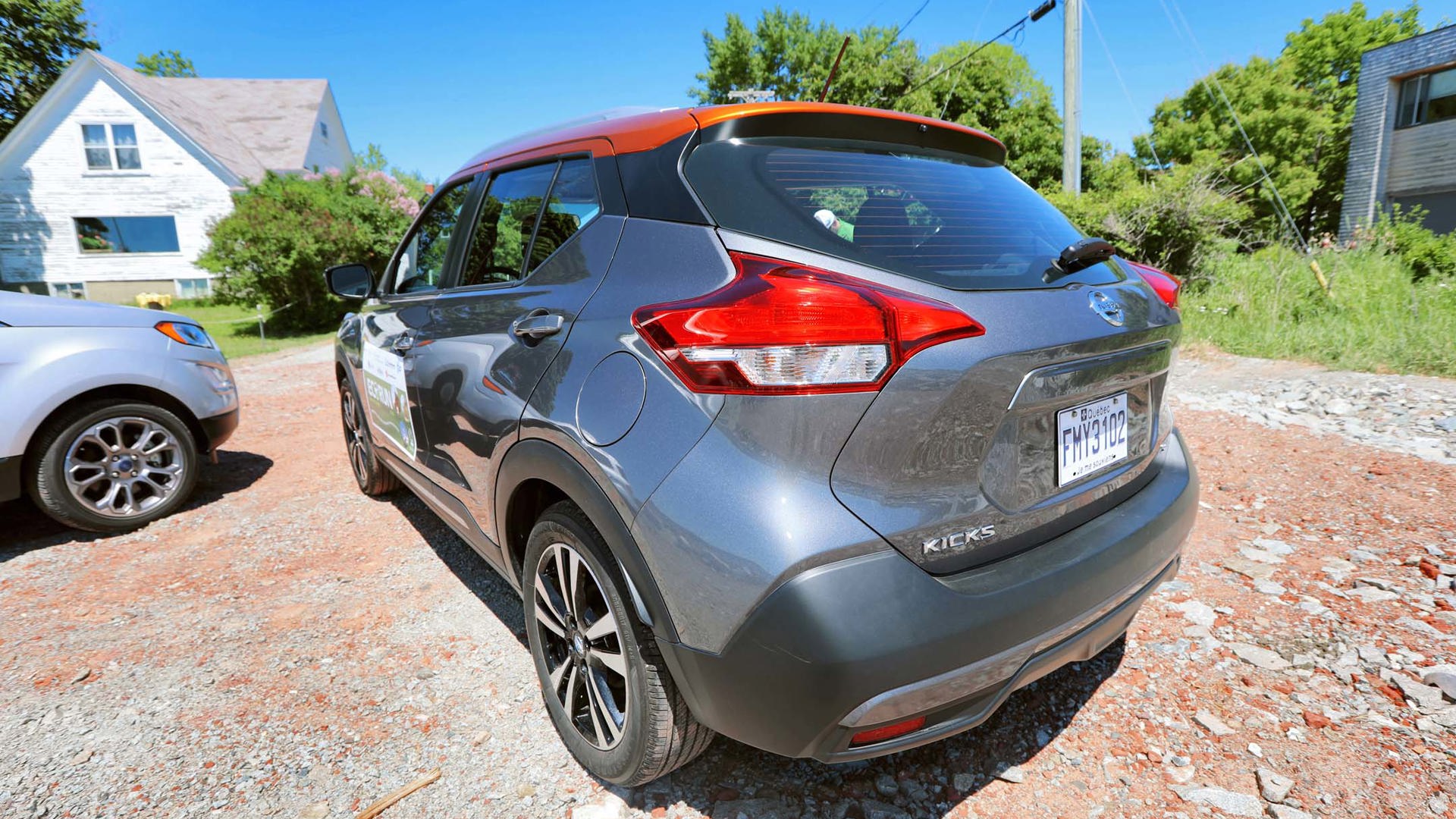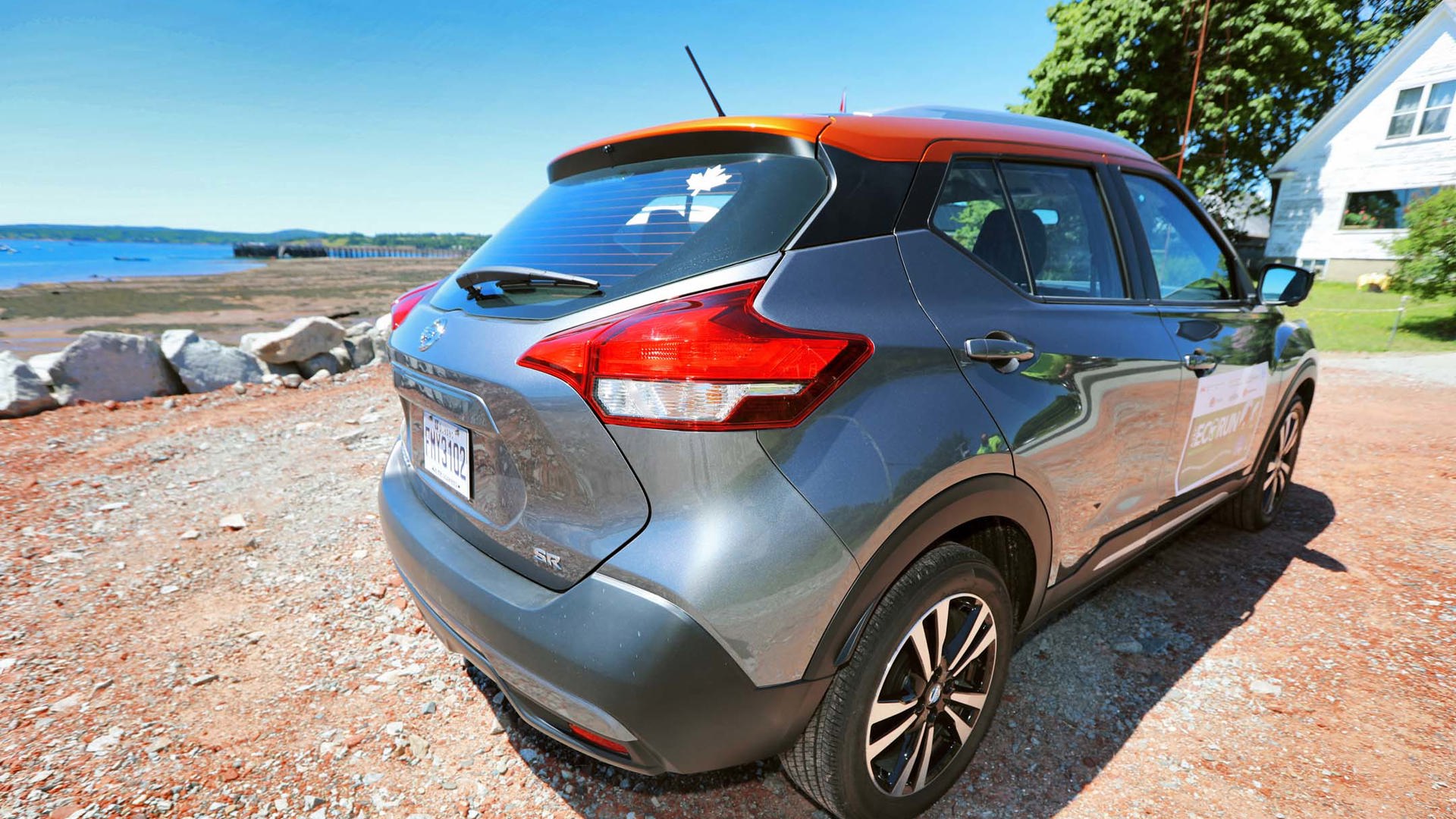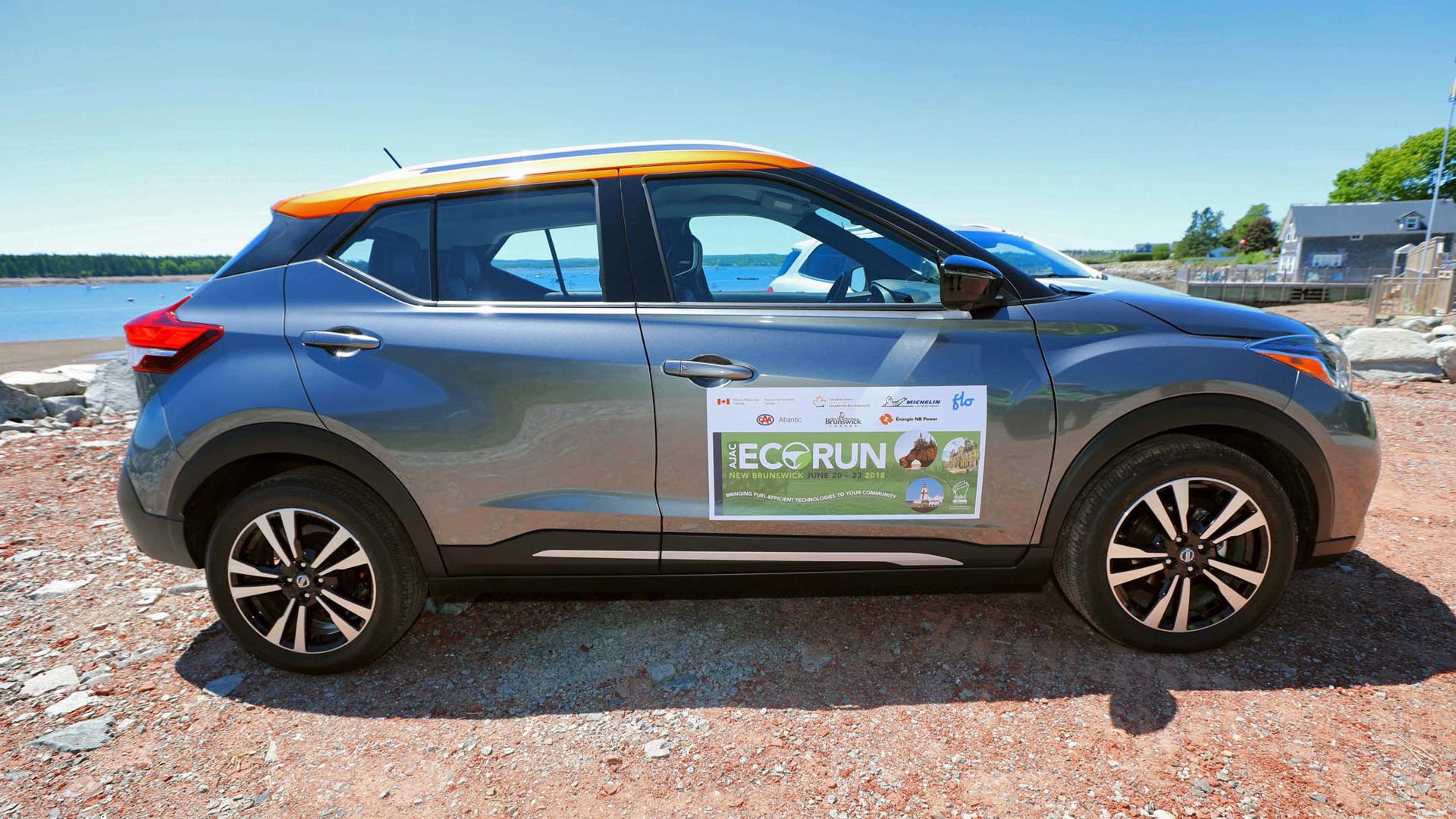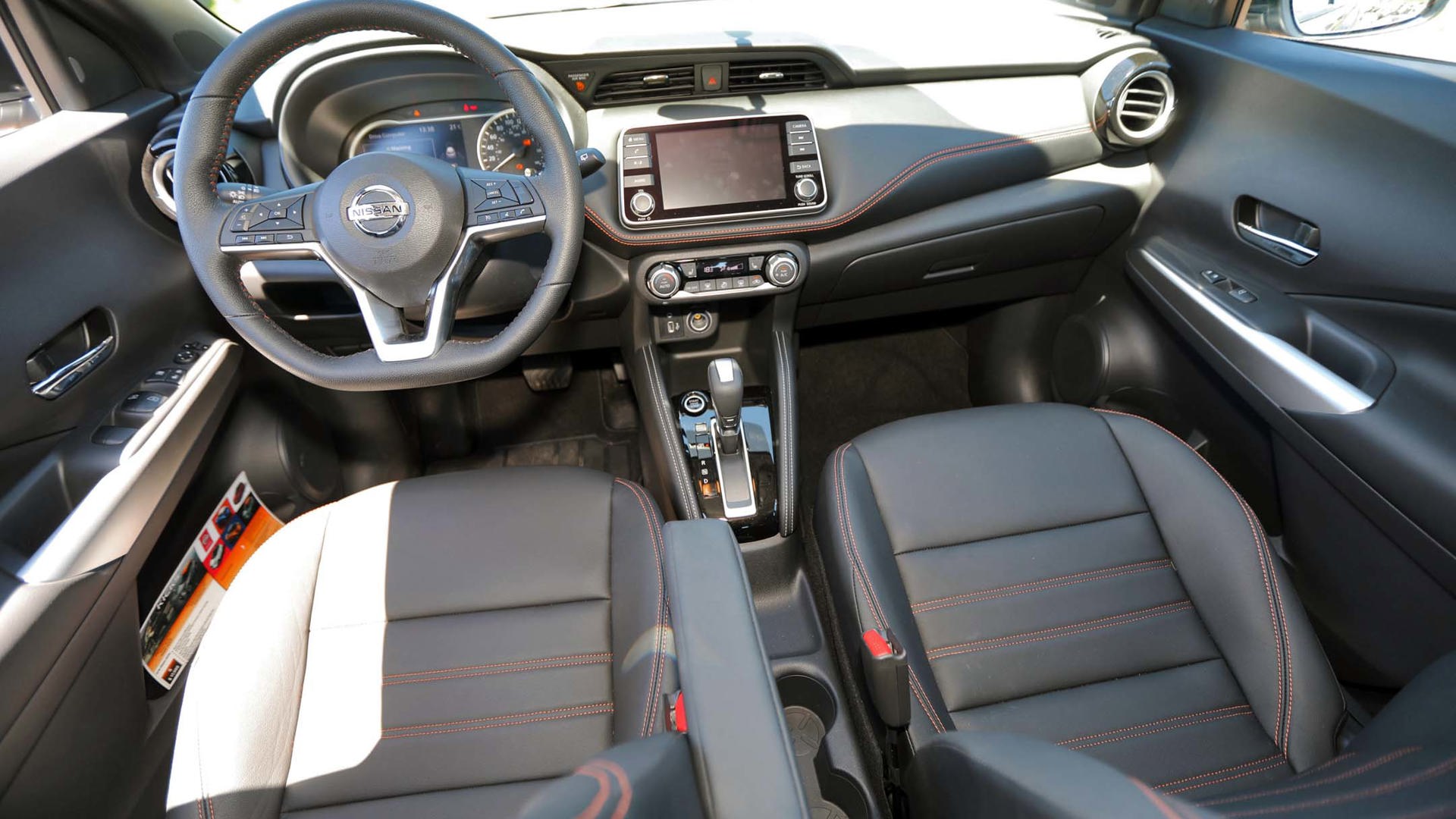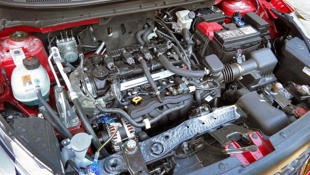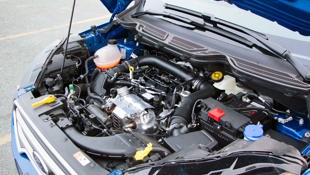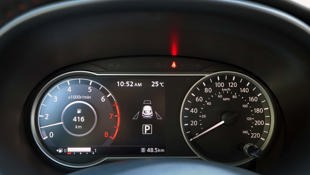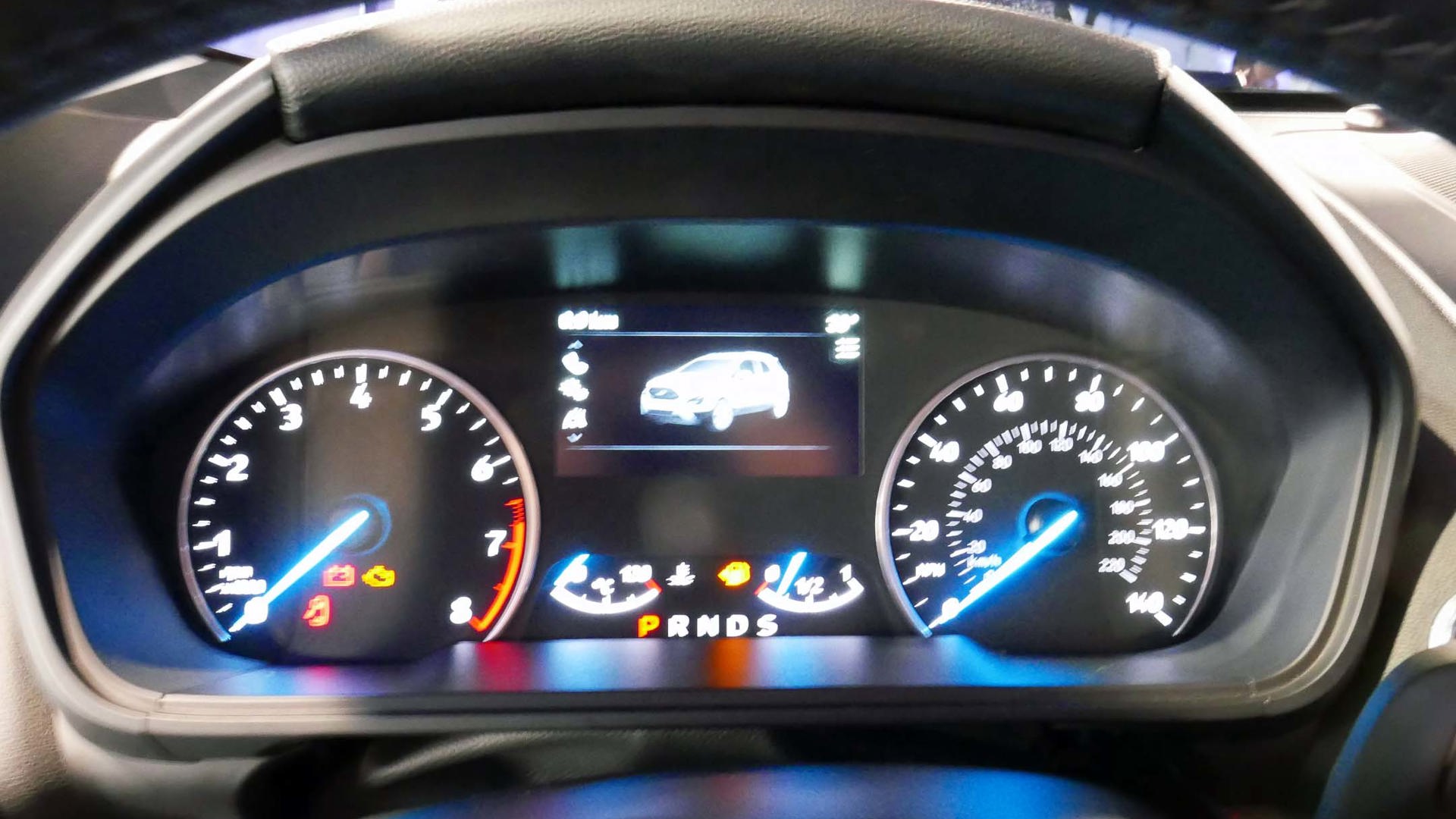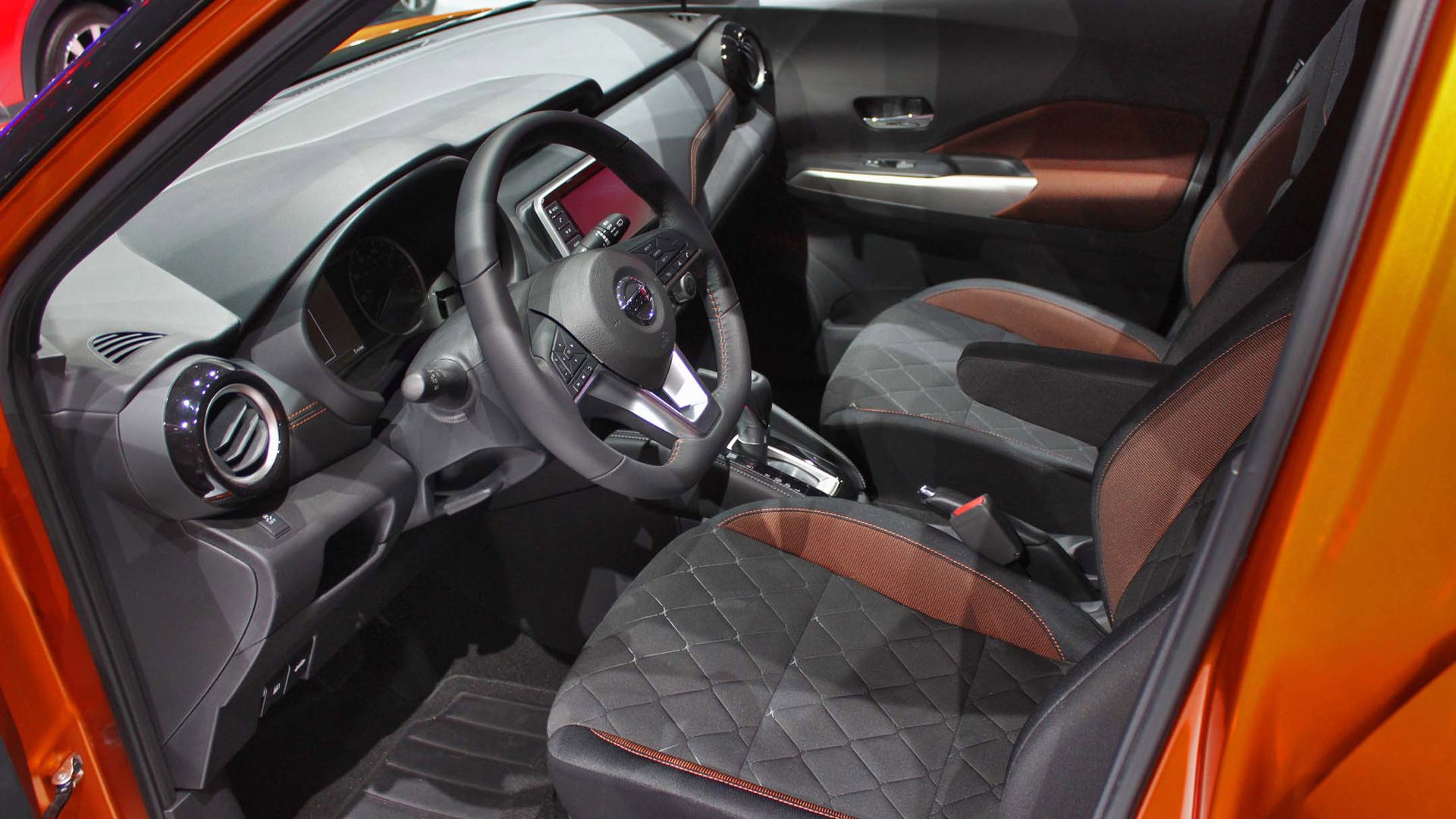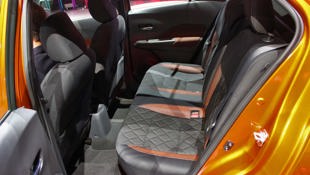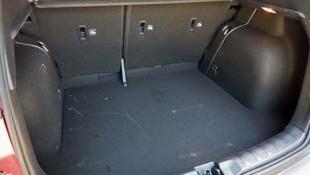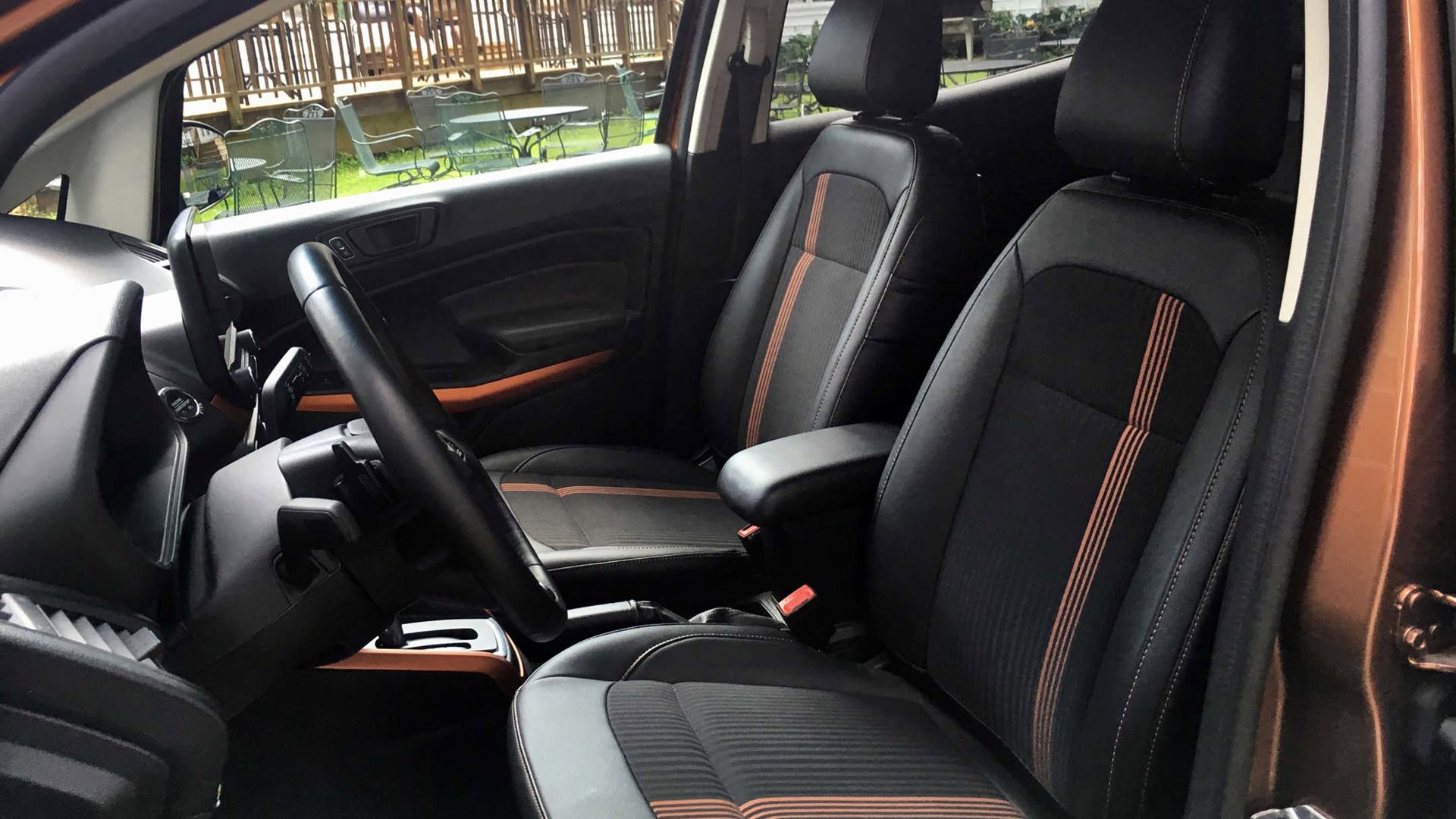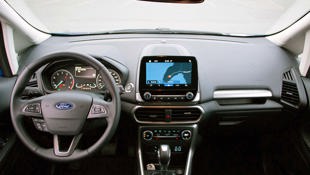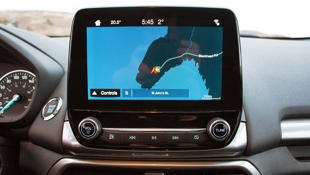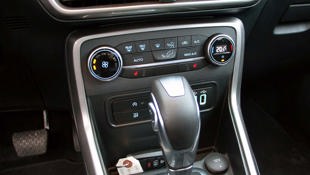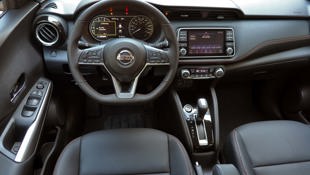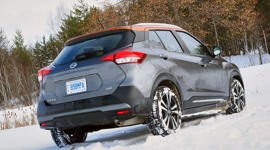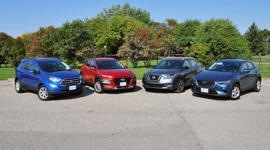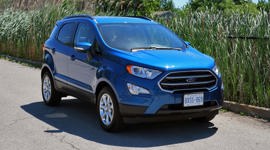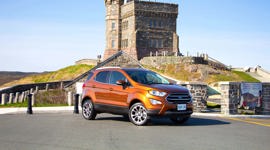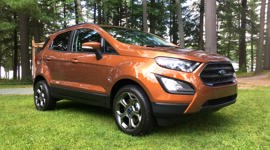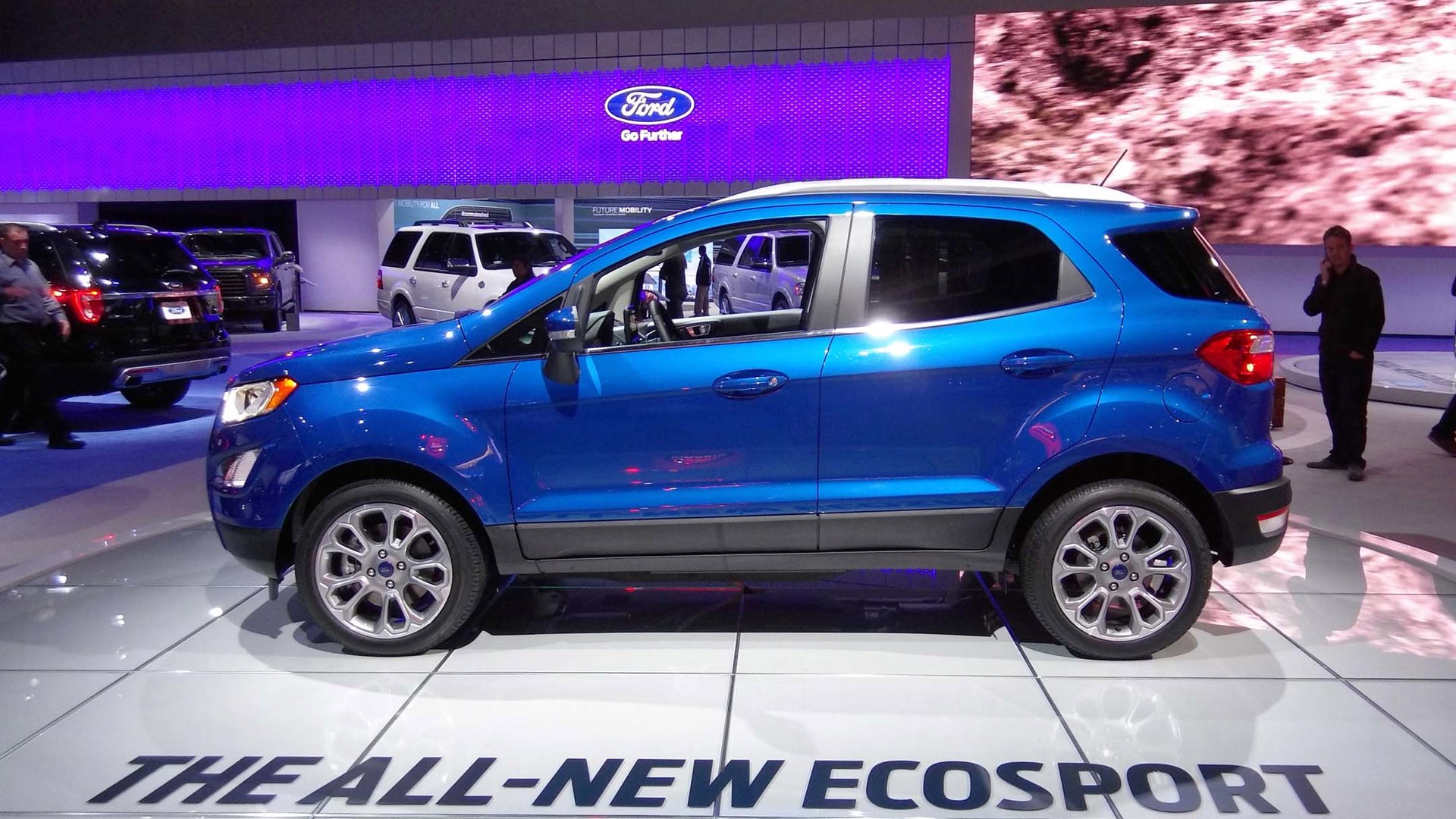Comparison Data
|
2018 Ford EcoSport Titanium FWD
|
2018 Nissan Kicks SR
|
|---|---|
|
Engine Displacement
1.0L
|
1.6L
|
|
Engine Cylinders
I3
|
I4
|
|
Peak Horsepower
123 hp @ 6,000 rpm
|
125 hp @ 5,800 rpm
|
|
Peak Torque
125 lb-ft @ 3,500 rpm
|
115 lb-ft @ 4,000 rpm
|
|
Fuel Economy
8.6/8.1/8.4 L/100 km cty/hwy/cmb
|
7.7/6.6/7.2 L/100 km cty/hwy/cmb
|
|
Cargo Space
592 / 1416 L seats down
|
716 / 915 L seats down
|
|
Base Price
$28,599
|
$22,798
|
|
A/C Tax
$100
|
$100
|
|
Destination Fee
$1,790
|
$1,795
|
|
Price as Tested
$30,489
|
$24,693
|
|
Optional Equipment
None
|
None
|
The AJAC EcoRun is an awesome opportunity to test the fuel-efficiency chops of a number of brand new vehicles, ranging from hybrids to EVs and everything in between. It also provides us with the rare opportunity to sample direct segment competitors back-to-back, on similar roads, and it’s an opportunity not to be wasted.
This one went down to the wire.
Two of the vehicles are about as direct a pair of segment competitors as you can get: the Ford EcoSport and Nissan Kicks are equally sized, similarly styled, and are both just arriving in North America after a few years working subcompact crossover markets abroad.
The cost of entry is much lower for the Kicks – starting at $17,998; the Ford, $22,099 – though both are aimed at the eco-conscious, techy city dwellers that are increasingly becoming the favourite target demographic for automakers, even though they don’t buy all that many cars.
These two are here to try and change that.
Powertrain
Ford EcoSport: 7/10
Nissan Kicks: 6/10
Although both have traditional petrol engines, these two have somewhat divergent powertrains: the Ford gets three cylinders plus a turbocharger good for 123 hp and 125 lb-ft; the Kicks, a naturally aspirated four-banger making 125 hp and 115 lb-ft. They also get very different transmissions, Nissan sticking by its tried, tested, and true continuously variable transmission (CVT), while the EcoSport gets a more traditional six-speed automatic. Neither is available with a manual.
It may come as little surprise, then, that the Ford is a little more engaging on the powertrain front. As fuel-efficient and linear as they are, CVTs take a lot of coaxing to get going, and you usually have to put up with some unseemly droning once they finally get on-boil, as it were. The EcoSport, on the other hand, is eager to please and haul you forward as it tries its best to show the benefits brought by its hatchback underpinnings.
“The powertrain in the EcoSport feels more like it’s fuel-efficient by default but ready to push a little harder when coaxed,” said autoTRADER.ca colleague Stephanie Wallcraft, who joined me on this comparison. “The Kicks has a similar feel of efficiency as standard, but the extra layer is missing.”
Drive Experience/Fuel Economy
Ford EcoSport: 6/10
Nissan Kicks: 7.5/10
Nissan claims that the Kicks has the best fuel economy in its class, and while their testing may have shown that, I saw the exact same fuel economy – 6.1 L/100 km – from both cars over very similar distances. That figure, by the way, is lower than what’s claimed by each manufacturer for highway driving. Hard not to call that an impressive feat.
So, on the fuel economy front, then, it’s a tie, right? Well, here’s the thing.
While the roads driven in each were similar, I had a passenger and his luggage with me when I tested the EcoSport, the added weight of which would negatively affect fuel economy, if only slightly. So what looks like a tie is actually a narrow win for the plucky (rarely is that adjective more applicable than it is here) Ford.
The Kicks wins back some points on the ride and handling front, however. It has responsive, even sporty steering and Nissan has found a suspension sweet spot, making the Kicks feel agile without having to rattle your vertebrae over tarmac imperfections.
The EcoSport, on the other hand, feels fine at the outset but rough and sometimes frustratingly brittle over those irritating highway cracks and dips more easily swallowed up by the Kicks.
On that point, Wallcraft disagrees.
“I found both of these cars to be fun to drive, but I thought the EcoSport was just a tiny bit more engaging,” she says. “It’s a hair sharper in cornering and feels more ready to pounce.”
Styling
Ford EcoSport: 6/10
Nissan Kicks: 8/10
While they may be similar in their packaging, Nissan has gone back to the well that made vehicles like the Micra and Juke (which the Kicks replaces) so unique: the contrast-colour roof and body (there are five combinations in total), plus other colourful body inserts as well as wing mirror caps and cool two-tone wheels add a little spice to the design, which is nice. The result is a funky little cute ’ute that stands out from the crowd, and one that is better aligned with the Mini Cooper Countryman and Toyota C-HR than the Honda HR-V, for example.
Or the Ford EcoSport. The brand-specific hexagonal grille and headlight lenses do their part to give the EcoSport a little bit of aggression to go with its cuteness, but somehow, the proportions aren’t quite right. It looks a little too high-roofed, and the way the skinny tires are pushed so far to the corners is a boon for interior room, but a little awkward-looking.
“I like the styling on the Kicks as well, and I think Millennials are going to love it,” Wallcraft adds. “But for those who prefer the understated, the EcoSport is nicely finished for its small and affordable package.”
I do like the way they’ve hidden the rear cargo door release in the chrome of the taillight, however; you may ask why they wouldn’t just hide it below the licence plate as so many others do, but the answer is simple: the EcoSport’s door opens sideways as opposed to up, so the latch is on the right side of the car.
I am embarrassed to admit, however, that I couldn’t find the door release at first. I needed someone with previous experience with the car to help me. To which I say: well met, Ford.
Speaking of cargo…
Interior and Storage
Ford EcoSport: 7/10
Nissan Kicks: 6.5/10
The “barn door” rear tailgate on the Ford has been met with some confusion amongst those who have sampled it previously. It opens quite wide, meaning you have to take a little more consideration when parking. Of course, it originates from Europe where tight street parking is the norm, so if they can figure it out, I’m sure we can, too. Once I did find that handle, I realized that the access left by the open door is generous, and it serves the double effect of working for both taller and shorter folk; taller EcoSporters won’t hit their head on the hatch, while the shorter among us don’t have to reach for the hatch to close it.
“I really don’t know about that side-opening door,” Wallcraft says. “It may not affect the usability as much as you’d think, but I couldn’t get used to it. I think it’s asking for more door dings in urban parallel parking situations.”
Of course, being a pretty small car to start with the latter probably wouldn’t be an issue all that often, but the peace of mind is there. I also like the EcoSport’s adjustable load floor, as it means that if you fold the rear seats flat, you get a much flatter surface than you would otherwise. There’s also more room back there than in the Kicks.
As far as the interior digs go: neither of these have all that much room in the back seats, but they’ll likely only be used for the kids anyway. Up front, the EcoSport has a slightly higher seating position than the Kicks – a few of my colleagues remarked (with some mirth that was slightly less than subtle) how much my 6'3" frame filled the Ford, but I heard nothing of the sort when behind the wheel of the Kicks. It feels the more spacious vehicle.
Infotainment and Connectivity
Ford EcoSport: 8/10
Nissan Kicks: 7/10
Tough hill to climb, here, for the Nissan. It’s not that its system is bad, it’s just that the Ford’s Sync3 interface is very good. The buttons are all nicely aligned, and the screen itself is one of the most responsive in the biz.
Both vehicles, meanwhile, get optional Apple CarPlay and Android Auto compatibility, but the Kicks has an ace up its sleeve courtesy of Bose. It provides a driver’s headrest-mounted speaker that adds a nice level of depth to the audio. It’s optional except on the top-spec SR trim, but if the kids are going to actually be buying the Kicks, I wouldn’t be surprised if more than a few of them select the special “Bose Personal Plus” audio system. It gives the Kicks a few additional points, but it’s not quite enough to edge the EcoSport here.
Other Features
Ford EcoSport: 8.5/10
Nissan Kicks: 6.5/10
The Kicks SR we tested was fitted to the max with everything you can get, while the EcoSport was more of an entry-level trim. You can spec it with a larger, 2.0-litre engine if you so choose, but I have to say that a big part of its attraction is that punchy yet efficient three-cylinder plant. They’re pretty much shot for shot otherwise, though you can spec the EcoSport with a moonroof, which is not an option with the Kicks. The EcoSport also gets auto stop-start as standard, a feature that isn’t available at all on the Nissan.
The big plus that the EcoSport offers over the Kicks, however, is the optional 4WD, which comes as standard on the top-spec SES package (and can only be had with the 2.0L otherwise). At $29,399, it costs a fair bit more than the top-spec Kicks SR trim seen here ($20,898), but for Canada especially, the option to get AWD is an attractive one.
Having said that, if you really want AWD for your Nissan CUV, there’s always the Qashqai, whose $24,898 base price (for AWD-equipped models) undercuts that of the EcoSport SES. For the purposes of this test, however, the EcoSport gets the nod for this section.
The Verdict
Ford EcoSport: 42.5/60
Nissan Kicks: 41.5/60
As expected, this one went down to the wire, and while the EcoSport did edge the Kicks on points, both vehicles will find their share of buyers. Both may be aimed at a youthful buying group, but I feel it’s the Kicks that ticks more options on that front, at a notably lower cost. I can see the EcoSport appealing to a slightly more buttoned-down group – empty nesters, perhaps, that want a smaller car that still gets you AWD and a nice, tall driving position. That group will likely find favour with the tailgate and moonroof, too. Personally, I’m happy these two tantalizing options to your typical hatch have finally made it to our shores.
